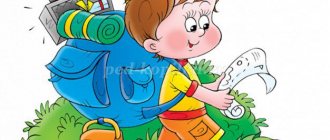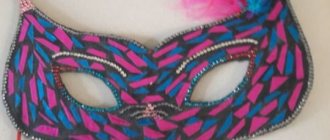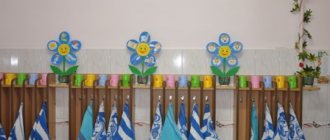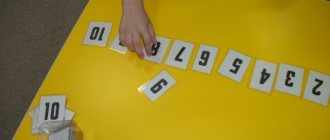Winter excursion to the park
Winter excursion to the park. (lesson notes for children 5-7 years old)
Senior group teacher: Zaymentseva Alexandra Alexandrovna
Lotoshino village, Moscow region
Type: intellectual - developing. Type of children's activities: musical and artistic, gaming, communicative, cognitive and research. Program content: to form children's ideas about the condition of trees and grasses in winter, about their adaptability to changing winter weather conditions; teach to distinguish trees by trunk and crown, expand ideas about tree buds and their purpose in the life of trees; arouse interest in changes in the life of plants in the park, develop the ability to find buds, compare the buds of different trees, make analyzes and conclusions, develop powers of observation; to cultivate a caring attitude towards trees and an aesthetic perception of winter nature. Planned results: development of integrative qualities “curious, active”, “emotionally responsive”, “mastered the means of communication and ways of interacting with adults and peers”, “able to manage one’s behavior and plan one’s actions based on primary value concepts, observing basic generally accepted norms and behavior rules". Preliminary work: examination of illustrations; reading educational literature; tree watching. Materials: magnifying glasses, plan of an ecological trail, poplar and elm buds, sticks, poplar branches with buds, table, pencil, slats. Vocabulary work: tubercles. Progress of the lesson: Uncle Au (the owner of the trail) comes to visit Uncle Au: Hello, guys! It's very cold outside - winter. Animals and plants no longer live as well as in summer. I want to invite you to the park. Let's see how plants and animals live in it. Would you like to see? Children: Yes Educator: You interested us, Uncle Au, let's go and have a look. The children come out, their path is blocked by the dog Barbos. Dog Barbos: Rrrrrrr, I'm the dog Barbos, I won't let you in until you solve the riddles. Educator: Guys, guess the riddles! Make a wish, Barbos the dog. Dog Barbos: Listen carefully. I powdered the paths, decorated the windows, and took them for a ride on a sled..(winter) What kind of artist applied leaves, grass, and thickets of roses to the glass? (Frost) Dog Barbos: Well done, you guessed all the riddles. Here's a plan for you to get to the park without getting lost. Goodbye! Educator: Guys, let's look at the plan together with Uncle Au to see if we got there. Children study the plan. Uncle Au: They came right. The park is beautiful at any time of the year. What time of year is it now? Children: winter. Uncle Au: How do you know that it’s winter now? What signs of winter do we see here? Children: The sky is gray, the sun is not warm, it’s cold, everything is covered with snow, the trees are bare, you can’t hear the birds singing. Educator: Correct. Everything is covered with snow, the trees are bare, you can’t hear the birds singing. Why are there no leaves on the trees? Children: The trees have lost their leaves and are in a state of sleep. Educator: How do you understand the expression: “the trees are sleeping”? Children: It’s very cold outside, the sun doesn’t shine much, the water is frozen, and the trees at this time have adapted to sleep, since they cannot grow in such conditions, but as soon as it gets warm, they will come to life again. Educator: Guys, how can you determine the name of a tree when there is no foliage on it? Children: Based on the trunk bark and the structure of the bark. Educator: Let's go to this tree. Do you recognize this tree? Children: Yes, it's a poplar. Educator: Look at him, what does he have? Children: Cora. Educator: What kind of bark does this tree have? Touch it. Children: it's smooth. Educator: What color is it? Children: grey. Educator: Where does the crown go? Children: The crown stretches upward. Educator: How tall is this tree? Children: high. Educator: Take magnifying glasses and look at the bark. What do you see? Children: There are cracks in the bark. Educator: Correct. Uncle Au: Guys, can you show me the maple tree? Children: Yes Uncle Au: Look what this tree has? Children: Root, trunk, crown. Uncle Au: Look at the bark, what is it like? Children: smooth, gray Uncle Au: How does the crown of this tree grow? Children: to the sides. Uncle Au: Guys, let's go look at the elm tree. Will you show it to me? Children: Yes Uncle Au: What kind of bark does the elm have? Children: dark, rough Educator: Touch and look closely, what do you feel? Children: tubercles. Educator: Look carefully at the bark through a magnifying glass. What do you see? Children: Lots of cracks. Educator: What is the difference between maple bark and poplar bark? Children: maple has smooth bark, but poplar has cracks. Educator: What kind of crown does the elm have? Children: A lot of thin branches Educator: How does the crown of an elm differ from other trees? Children: she is very rough Educator: Now you know how you can distinguish trees in winter. Uncle Au: Now, guys, I’ll show you something interesting. What did you notice on the branches? Children: Lumps. Uncle Au: What do you think it is? Children: kidneys. Educator: Let's find out if this is true. I will give each of you a twig and a stick. Look at them and tell me how a twig differs from a stick? Children: · there are buds on the branch, but not on the stick. Educator: Take off the mitten and open the bud on the branch. Children examine the structure of a kidney and discuss what they see among themselves. -What is a kidney? Children: tightly rolled small leaves. Educator: Let's look at the kidneys carefully. What size are they? Children: small. Educator: What color are they? Children: brown. Educator: What shape are they? Children: round. Educator: look at how the buds are located on the branch. Why do you think they are covered with brown scales on top? Children: They protect tender leaves from rain, snow and cold. Uncle Au: Guys, why do you think your coats don’t unbutton in the wind? Children: They are buttoned up. Uncle Au: Why don’t the scales unfasten in the wind? Children: they also seem to be buttoned up. Educator: Guys, look carefully at the scales and your sticky fingers. What do you feel, what are the scales covered with? Children: The scales are glued together with a special resin. Uncle Au: Now do you know what kind of tubercles are on the branches? Children: yes Uncle Au: What is this? Children: kidneys Uncle Au: What are they covered with? Children: Scales. Educator: Look carefully at the kidneys. Are they the same on all trees? Children: different Educator: How are they different? Children: size, shape. Uncle au: Guys, look what buds you see here? Children: Large and small, which means the leaves on the trees are different - large and small. Educator: Look carefully around and determine by the shape from which tree or bush the buds that we are now looking at were taken? Children examine the surrounding plants and find this tree. Educator: Well done! What is this tree called? Children: poplar Teacher: In the summer you saw its leaves, and now remember what it looks like without them. Look, is there another tree like this here? What tree did you get the buds from? Children: Elm Uncle Au: Guys, you and I have seen different trees. Tell me, how have they adapted to endure harsh winter conditions? Where do you think the grass is now? Children: died. Educator: You think you died. Let's check. Uncle Au: I have shoulder blades with me. Boys, dig up the snow right down to the ground. Educator: Look, what do you see? Children: The grass is not frozen. Educator: what color is the grass? Children: green. Educator: Snow is like a blanket for her, preventing intense cold from reaching the ground. What is left alive in the soil? Children: roots, seeds. Educator: Now fill the excavated area with snow again so that the grass does not freeze. Guys, now we will check whether the depth of snow is the same in different places. Divide into pairs. I will give each pair a staff and a pencil. You will walk around the park, stick a pole into the snow in different places, trying to reach the soil, and draw a line with a pencil to mark the snow level. Now Uncle Au and I will show you how to do it correctly. One of you holds the staff, the other holds the pencil (show). Try to find places where the snow is very deep, medium, and where there is almost no snow. Children perform a task that replaces physical education. -Show me the chopsticks. Is the snow depth the same in different places? Children: No Educator: Where is the grass better preserved - where there is a lot of snow, or where there is little? Children: where there is a lot. Educator: of course. Let's admire the beauty of our park. Look at the trees. You can see each branch, how they are bent and intertwined with each other. Look how beautifully winter covers the trees and shrubs. How everything glitters, how it sparkles in the sun. How beautiful it is all around! This beauty must be protected. In winter, all branches become fragile, they must be handled carefully, they should not be broken, in spring and summer they will delight us. Winter has prepared all the colors for everyone, The best white for the fields, Scarlet ink for the dawns, Clean silver sparkles for all the trees. All day long winter forges green ice on the river. (V. Fetisov) -Which plant do you like best? Children: maple Uncle Au: Guys, I want to play a game with you: “Run to the named tree.” We will divide into three groups. I will name three trees in a row. The 1st group runs to the tree named first, the 2nd group runs to the second, the 3rd group to the third. Listen carefully: poplar, elm, maple. Educator: Well done! By what characteristics did you identify these trees? Children: on the bark of a tree. Uncle Au: Guys, did you like it in the park? What new and interesting things did you learn? Children: how to find out the name of a tree by its bark. Uncle Au: Well done! It's time for me to leave. Goodbye, see you again!
List of used literature: L.A. Egorova “Cognitive and research classes with children 5-7 years old V.A. Shishkina “Walks in nature” M.: Education, 2002 T.A Shorygina “Trees. What are they like? V. Fetisov “Winter has prepared”



